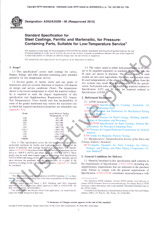We need your consent to use the individual data so that you can see information about your interests, among other things. Click "OK" to give your consent.
ASTM D8407-21
Standard Guide for Measurement Techniques for Formaldehyde in Air
Translate name
STANDARD published on 1.9.2021
The information about the standard:
Designation standards: ASTM D8407-21
Publication date standards: 1.9.2021
SKU: NS-1046343
The number of pages: 9
Approximate weight : 27 g (0.06 lbs)
Country: American technical standard
Category: Technical standards ASTM
Annotation of standard text ASTM D8407-21 :
Keywords:
advantages, cavity ringdown, chemical ionization mass spectrometer, chromotropic acid, derivatization (DNPH, 2,4-Dinitrophenylhydrazine), derivatization (Hantzsch reaction), electrochemical cell, formaldehyde, FTIR spectrometer with optical filter, laser absorption spectrometer, limitations, photoacoustic, pre-concentration and thermal desorption, quantification,
Additional information
| Significance and Use |
|
5.1?The objective of this guide is to provide the user with an information base on commercially available instruments and technologies that can be used to measure indoor air formaldehyde concentrations. 5.2?This guide is intended as a repository for formaldehyde measurement technologies that other approved ASTM methods can reference to meet ASTM indoor air formaldehyde quantification needs. 5.3?This guide does not discuss the equivalency of the technologies presented. Each technology may have positive or negative interferences that are unique to that technology. When using a new method, equivalence with old methods should be demonstrated for each matrix, measuring environment and media (that is, each type of wood for formaldehyde emission testing in chamber environments). This is especially true when the method is intended to generate regulatory compliance data. Demonstrating equivalence or compliance, or both, is beyond the scope of this method. For guidance equivalence see references such as 40 CFR ? 136.6 and CEN Guide to the Demonstration of Equivalence of Ambient Air Monitoring Methods 1.1?This guide describes analytical methods for determining formaldehyde concentrations in air. 1.2?The guide is primarily focused on formaldehyde measurement technologies applicable to indoor (including in vehicle and workplace) air and associated environments (that is, chambers or bags, or both, used for formaldehyde emission testing). The described technologies may be applicable to other environments (ambient outdoor). 1.3?This guide reviews a range of commercially available technologies that can be used to measure indoor air formaldehyde concentrations. These technologies typically can measure airborne formaldehyde concentrations with detection limits in the range of 0.04 ppb1.4?This guide describes the principles behind each method and their advantages and limitations. 1.5?This guide does not attempt to differentiate between the effectiveness of the methods nor determine equivalence of the methods. 1.6?The values stated in SI units are to be regarded as standard. No other units of measurement are included in this standard. 1.7?This standard does not purport to address all of the safety concerns, if any, associated with its use. It is the responsibility of the user of this standard to establish appropriate safety, health, and environmental practices and determine the applicability of regulatory limitations prior to use. 1.8?This international standard was developed in accordance with internationally recognized principles on standardization established in the Decision on Principles for the Development of International Standards, Guides and Recommendations issued by the World Trade Organization Technical Barriers to Trade (TBT) Committee. |
We recommend:
Technical standards updating
Do you want to make sure you use only the valid technical standards?
We can offer you a solution which will provide you a monthly overview concerning the updating of standards which you use.
Would you like to know more? Look at this page.




 Cookies
Cookies
